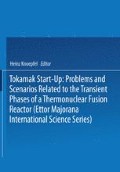Abstract
Experimental confirmation of noninductive current drive has spawned a number of suggestions as to how this technique can be used to extend the fusion burn period and improve the reactor prospects of tokamaks. Several distinct burn cycles, which employ various combinations of Ohmic and noninductive current generation, are possible, and we will study their relative costs and benefits for both a commercial reactor as well as an INTOR-class device. We begin with a review of the burn cycle options.
Access this chapter
Tax calculation will be finalised at checkout
Purchases are for personal use only
Preview
Unable to display preview. Download preview PDF.
References
C. C. Baker et al., “STARFIRE - A Commercial Tokamak Power Plant Study,” Argonne National Laboratory Report, ANL/FPP/80–1 (1980).
D. A. Ehst et al., J. Fusion Energy 2 (1982) 83.
M. Porkolab et al., “Lower Hybrid Current Drive and Heating Experiments at the 1-MW RF Power Level on Alcator C,” 11th European Conference on Controlled Fusion and Plasma Physics, Aachen, West Germany, 1983.
R. Motley et al., in Proc. of IAEA Technical Committee Meeting, Culham, England, CLM-CD (1983), Vol. ii (1983), 299.
N. J. Fisch, “Operating Tokamaks with Steady-State Toroidal Current,” Princeton Plasma Physics Laboratory Report, PPPL-1772 (1981).
N. J. Fisch, in Proc. 3rd Joint Varenna-Grenoble International Symposium on Heating in Toroidal Plasmas, EUR7979EN, Vol. iii (1982) 841.
C. E. Singer and D. R. Mikkelsen, J. Fusion Energy 3 (1983) 13.
R. A. Bolton et al., in Proc. 3rd Top. Mtg. on Technology of Controlled Nuclear Fusion, CONF-780508, Vol. ii (1978) 824.
M. A. Abdou et al., “A Demonstration Tokamak Power Plant Study (DEMO),” Argonne National Laboratory Report, ANL/FPP-82–1 (1982).
D. A. Ehst et al., “Tokamak Burn Cycle Study,” Argonne National Laboratory Report, ANL/FPP/TM-178 (1983).
D. A. Ehst et al., “A Comparison of Pulsed and Steady State Tokamak Reactor Burn Cycles-Part I: Thermal Effects and Lifetime Limitations,” Nucl. Eng. and Design/Fusion (to be published, Vol. 2, Issue No. 4, 1985 ).
D. A. Ehst et al., “A Comparison of Pulsed and Steady State Tokamak Reactor Burn Cycles-Part II: Magnet Fatigue, Power Supplies and Cost Analysis,” Nucl. Eng. and Design/Fusion (to be published, Vol. 2, Issue No. 4, 1985 ).
D. A. Ehst, J. Fusion Energy 1 (1981) 357.
W. M. Stacey, Jr. et al., USA FED-INTOR/82–1 (1982).
Author information
Authors and Affiliations
Editor information
Editors and Affiliations
Rights and permissions
Copyright information
© 1986 Springer Science+Business Media New York
About this chapter
Cite this chapter
Ehst, D.A. et al. (1986). A Comparison of Tokamak Burn Cycle Options. In: Knoepfel, H. (eds) Tokamak Start-up. Ettore Majorana International Science Series. Springer, Boston, MA. https://doi.org/10.1007/978-1-4757-1889-8_4
Download citation
DOI: https://doi.org/10.1007/978-1-4757-1889-8_4
Publisher Name: Springer, Boston, MA
Print ISBN: 978-1-4757-1891-1
Online ISBN: 978-1-4757-1889-8
eBook Packages: Springer Book Archive

